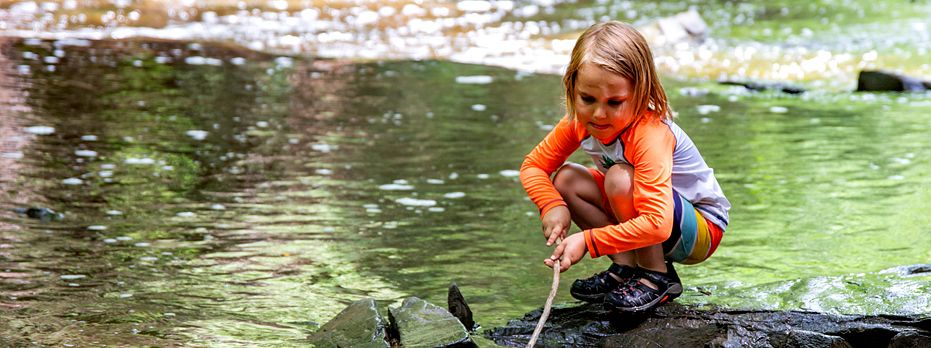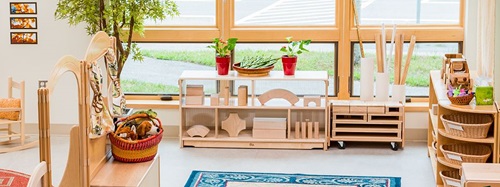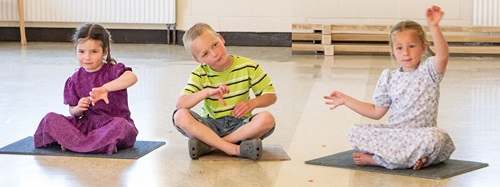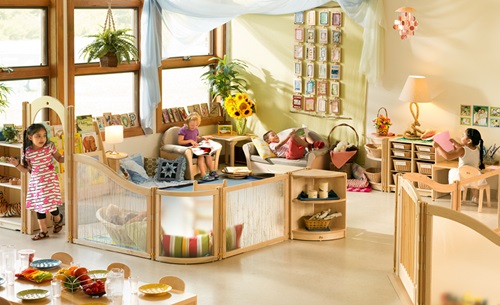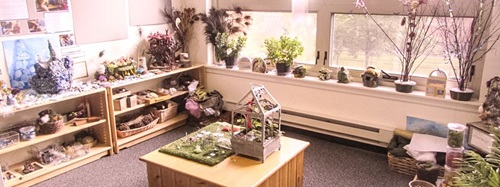Learning Through Nature
Growing up in a Natural Montessori Environment
|
March 2014
Growing up in the Australian outback, the world of Montessori and modern education was a distant idea. But today, after I have had many years of experience and have developed a strong philosophical and practical education ethic, I believe I grew up closer to Montessori than I knew. We, as Montessori educators, believe there are a number of important factors that are necessary for a child to successfully attain adulthood. They include family, a stable home, good adult mentors, and a strong system of education that includes fostering of independence, autonomy of the individual, and joyful learning opportunities with a system of choice and a strong prepared environment.
I would like to mention one additional element that I believe to be of equal importance in a child’s life, and that is unstructured and unrestricted outdoor and nature play. Richard Louv, in his book Last Child in the Woods (2008), speaks of the “Nature Deficit Disorder” he sees in many of today’s children. I see this as well, and in my role as the head of a Montessori school set on 400 acres, and as the head of an Outdoor Environmental Education program, I aim to correct this deficit.
I would like to tell the story of my own childhood, how it mirrored a Montessori education in its most authentic form, and how the elements of the natural world contributed to my education and helped me in later life to truly understand Montessori. My education was unconventional, to say the least.
System of Education
The setting is St. Joseph’s Catholic School, a small cluster of stone buildings at the bottom of Gillagala Hill on the outskirts of Merriwa, a rural town of 500 people in northwest New South Wales, Australia. It was in this one room schoolhouse that I received my “formal education.” We pupils sat in rows, inkwells full, and listened to repetitive instructions of which I have no memory. But it was not in this classroom that I truly received my education. Each day I would wake up on our sheep station with my four brothers and two sisters. We would do our chores and then walk a mile to the bus stop for the rough and ragged journey to school.
On this journey, I would start my schooling. As the notorious “naughty boy,” my designated seat was up front, on an old apple box next to the driver. My engineering education came from being up close and personal with the bus engine and the gearing system. As I was not permitted to talk for the 1½- hour journey, and the scenery got boring, I found other ways to engage my energies. As there was no lid to the engine housing in this bus, the driver constantly had to refill the radiator so the bus would not overheat. I would watch the engine rattle and groan, and the driver rev and change gears, until I knew every working part of the bus. On one occasion, to try to understand the tension applied to the brake pedal for the bus to stop, I reached my foot across and slammed down on the brake pedal while the bus was in full motion. We stopped, all right, and I learned that it took a lot of my weight to push the brake pedal to the floor; I also learned, through a sore bottom, that placing one’s foot on the brake randomly was not a good idea.
Once at school, the school yard was my science and engineering laboratory, with inconvenient interruptions of classroom work. My days would include building ant traps, constructing forts out of sticks and discarded rope, and climbing trees to prevent detection from those who were chasing me in games. I would undo the water faucet on the children’s bubbler system, releasing water to run along the dirt so I could construct dams and experiment with flooding and altering water courses. I would plant random seeds in the nuns’ petunia gardens to see if they would grow, and as they did I would weed out the petunias so my wheat and oat seeds would get more light. I would ring the church bell to see how high off the ground the weight of the bell could lift me and drop the chalk on the floor to see if it consistently broke into three pieces.
All of these experiences, though not popular with my teacher or my parents, are lessons I learned and can remember. They combined to become my system of education. These small and somewhat innocent experiments in life would lead to much greater experiments in my later years.
Independence: Autonomy of the Individual
From my earliest memory, the outside environment felt natural to me; I spent hours along the creek, catching frogs and watching snakes and looking for eels. I spent days combing the mountains, looking in caves and discovering new plants, and lying in meadows of ferns looking up at the sky trying to see pictures in the clouds. My father gave me a horse at the age of 5. I had no bridle or saddle, but I already knew how to ride. It was also my responsibility to feed, water, and brush my horse, as well as ride him as much as possible. At the time, I did not realize the important life lessons being instilled in me. My independence was being fostered and strengthened. I was learning my limits and my ability to get whatever I needed to succeed.
Multi-age Learners
Multi-age learning environments seem to me to be as natural as falling off a log. In my community, children from many age groups learned and played together. Much of what I learned growing up on the farm was from my older brothers. On long hot summer days, we would spend hours in the creek, swimming and skipping rocks. I learned how to replace the spark plug on the lawn mower from my brother, I learned how to shoe a horse from my father, and I learned how to dig for yams in the mountains from a neighbor boy.
I also learned to be streetwise and to question when asked to do something. For example: My three older brothers had been spending weeks building a go-cart with an engine removed from our old lawn mower. The frame of the cart was made of wood and iron, strapped together in many ingenious but perhaps less-than-stable ways. The big day arrived when the prototype go-cart would go for its debut run.
Being the youngest of the four, it was decided that I should be the first to ride. I was strapped in with my father’s old army belt, and the engine was fired up. I was given strict instructions that I was only to release the brake when I was told. In releasing the brake, the go-cart would plummet forward. However, I was given no instructions on steering the go-cart. With the engine revving at full RPMs, my brothers set me in motion, and I flew directly toward the nearest tree. Lesson learned: Beware of some honors that are bestowed upon you.
Prepared Environment
My prepared environment was my outdoor world. It was perfectly prepared each and every day; it was prepared with me in mind; and it was prepared to challenge me, to inspire me to immerse myself in what I was doing. This prepared environment was Nature. It was not adapted with fences to keep me in or to keep others out; it was not prepared with special pathways for me to explore or manicured grass for me to lay on; it was not prepared with swings for me to swing on or slides for me to slide down on or little pools for me to play in. It was Nature, in its raw form, with its broken stumps I could climb on as king of the world, its dandelion and thistle flowers I could pick for my mother, its creek banks I could catch frogs in, its overgrown hedges I could climb into to make my fort. Nature need not design for children, nor engineer to create play-scapes or boundaries; it has everything a child could possibly want, and it will inspire imagination.
I have had a fortunate life, and I talk a lot about my childhood and my adulthood. People often ask me, “But I live in the city—there are dangerous people there. What about my child’s safety?” The safety and well-being of his or her child is, of course, every parent’s concern. To this, I answer: We can let our fears and our prejudices control and rule us or we can trust in our own judgment and thus build trust in our children. How is a child to learn independence if we never allow her to do anything for herself? How is a child to learn whom to trust and whom to be aware of if we do not allow him to explore humanity? A fall for a 1-year-old is a normal part of daily life, while a fall for a 35-year-old could mean serious injuries, and a fall for a 90-year-old can be fatal.
Our children need to fall, they need to climb, and they need to get dirty. They need to experiment and to stretch their limits. If we as adults force them to wait until they are 18 to fall or to get dirty, the consequences will be devastating. Let us not allow our gated communities and our restrictive subdivision associations to limit our children’s ability to experience life for themselves. Allow them the freedom to explore, allow them to discover the world that will one day be theirs. My parents gave me a gift—it was the gift of Nature as a prepared environment, a place to play freely. Let us give every child the same gift.
© 2013 American Montessori Society. Excerpted from Montessori Life, Fall 2013, and published with permission. A full-length version of the article can be found on the Family Support Materials page of the AMS website.

